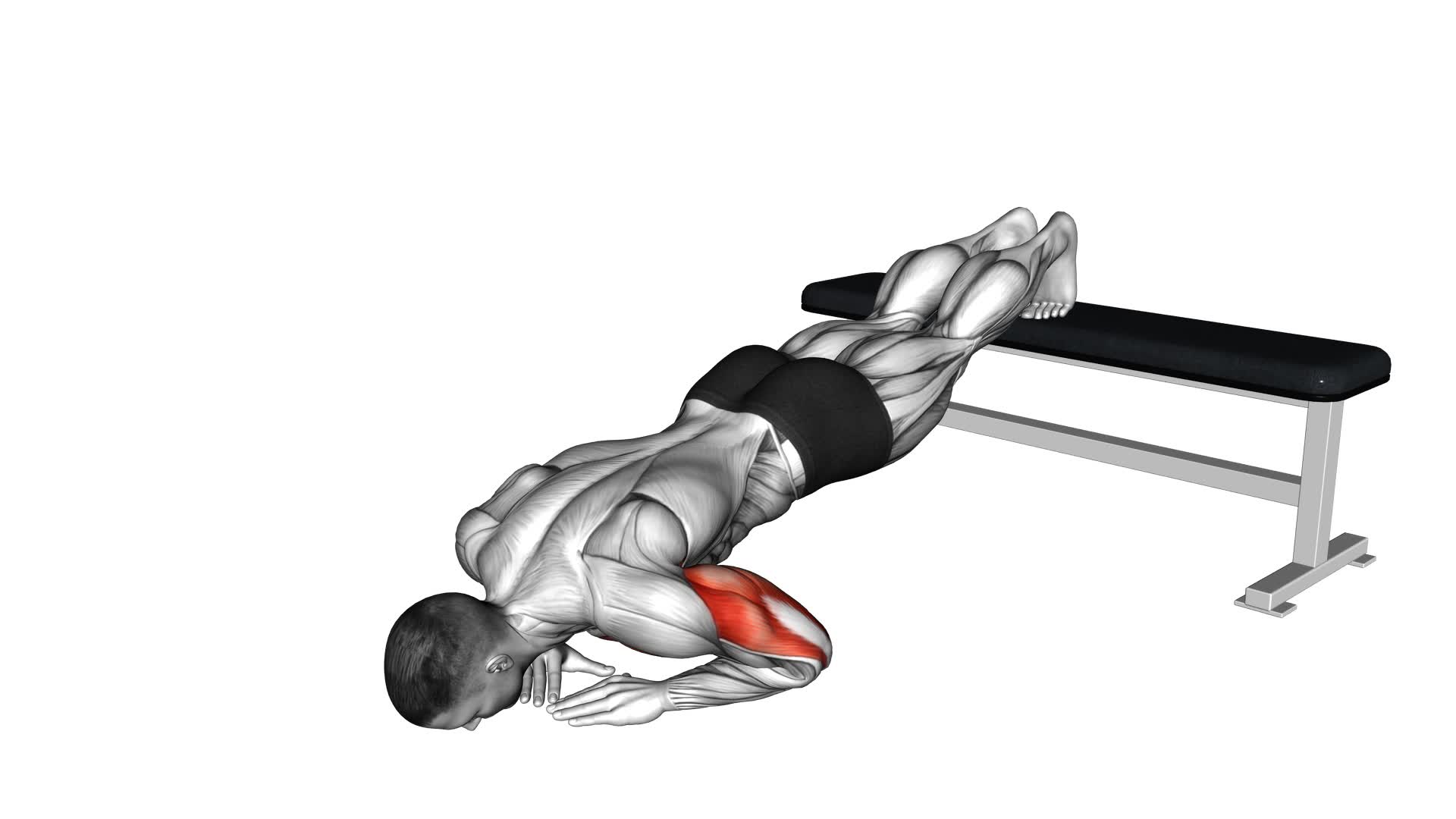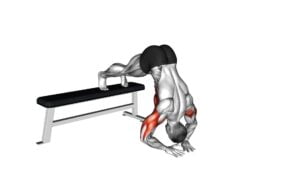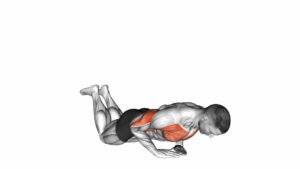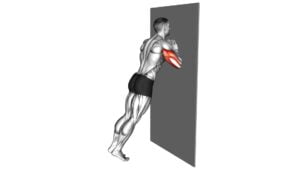Decline Diamond Push-up – Video Exercise Guide & Tips

Are you looking for a challenging upper body exercise that targets your chest and triceps? Look no further than the decline diamond push-up!
Watch This Exercise Video
This article will guide you through the proper form and technique of this exercise, as well as provide variations to increase intensity. Avoid common mistakes and get the most out of your workout with these helpful tips.
Get ready to feel the burn and build strength with the decline diamond push-up.
Key Takeaways
- Decline diamond push-ups target the triceps more intensely than traditional push-ups and help strengthen and tone the triceps.
- Performing decline diamond push-ups can enhance the overall appearance of the arms and build upper body strength.
- Proper form and technique, such as maintaining a diamond hand placement and engaging the core, are crucial for safety and optimal results.
- Incorporating variations and gradually increasing the difficulty can challenge the muscles for strength and growth.
Benefits of Decline Diamond Push-ups
To maximize your upper body strength and target your triceps, incorporating decline diamond push-ups into your workout routine can be highly beneficial.
Decline diamond push-ups primarily target the triceps, which are the muscles located on the back of your upper arm. By positioning your hands close together in a diamond shape and performing the push-up on an inclined surface, you engage your triceps even more intensely than with traditional push-ups.
Incorporating decline diamond push-ups into your workout routine allows you to specifically focus on strengthening and toning your triceps. This exercise not only helps you build upper body strength, but also enhances the overall appearance of your arms. By consistently performing decline diamond push-ups, you can achieve more defined and sculpted triceps.
To properly execute decline diamond push-ups, it's important to maintain proper form and technique. This will ensure that you're effectively targeting your triceps and minimizing the risk of injury.
Now that you understand the benefits of decline diamond push-ups, let's dive into the proper form and technique to maximize your results.
Proper Form and Technique
Now, let's delve into how to properly execute decline diamond push-ups to maximize your results and minimize the risk of injury.
To perform decline diamond push-ups with proper form and technique, follow these steps:
- Start by positioning yourself in a standard push-up position, but with your feet elevated on a bench or step. Place your hands close together, forming a diamond shape with your thumbs and index fingers on the floor.
- Lower your body towards the ground, keeping your elbows tucked in close to your sides. Remember to engage your core and keep your back straight throughout the movement.
- Maintain control as you push yourself back up to the starting position. Focus on squeezing your chest and triceps at the top of the movement for maximum activation.
By executing decline diamond push-ups correctly, you can effectively improve your upper body strength. However, if you're a beginner or find this exercise challenging, consider these modifications:
- Perform the exercise on an incline, such as using a sturdy chair or countertop, to decrease the intensity.
- Place your hands wider apart to make the exercise easier and lessen the strain on your triceps.
Now that you know the proper form and modifications for beginners, let's move on to the next section about variations to increase intensity.
Variations to Increase Intensity
Increase the intensity of your decline diamond push-ups with these variations.
To target your muscles more effectively, try incorporating advanced modifications into your routine. One option is to elevate your feet on a bench or step, which increases the incline and places more emphasis on your upper chest and shoulders. This will challenge your muscles even further and help you build strength and definition in those areas.
Another variation is to add a resistance band around your back and hands. This will provide extra resistance throughout the movement, making it more challenging for your muscles.
Additionally, you can try performing decline diamond push-ups on an unstable surface, such as a balance ball or Bosu ball. This forces your muscles to work harder to stabilize your body, increasing the overall intensity of the exercise.
Remember to always maintain proper form and technique while performing these advanced modifications to avoid injury.
Incorporate these variations into your decline diamond push-up routine to take your workout to the next level and continue challenging your muscles for optimal strength and growth.
Common Mistakes to Avoid
Avoid these common mistakes when performing decline diamond push-ups to ensure proper form and maximize the effectiveness of the exercise.
- Incorrect hand placement: Placing your hands too close together or too far apart can reduce the effectiveness of the exercise and put unnecessary strain on your wrists. Keep your hands directly under your shoulders and form a diamond shape with your thumbs and index fingers.
- Sagging or arching your back: Maintaining a straight line from your head to your heels is crucial for proper form. Avoid sagging your hips or arching your back, as this can lead to a loss of stability and potential lower back pain.
- Lifting your hips too high: Raising your hips too high can shift the focus away from your chest and triceps, limiting the effectiveness of the exercise. Keep your body in a straight line throughout the movement.
Modifications and progressions can help you improve your decline diamond push-ups:
- Modifications: If you're finding it difficult to perform decline diamond push-ups, you can modify the exercise by performing regular diamond push-ups on the ground or on an incline surface. This will help you build strength before progressing to the decline variation.
- Progressions: Once you have mastered decline diamond push-ups, you can further challenge yourself by adding weight to your back or elevating your feet on a higher surface. These progressions will increase the intensity and continue to stimulate muscle growth.
Tips for Getting the Most Out of Your Workout
To optimize your workout, make sure to incorporate these tips while performing decline diamond push-ups. By following these tips, you can maximize your results and ensure that you're getting the most out of your workout.
Firstly, it's important to maintain proper form throughout the exercise. Keep your body straight and engage your core muscles to avoid any strain on your lower back. This won't only help you target your chest and triceps effectively but also minimize the risk of injury.
Secondly, focus on your breathing. Exhale as you push yourself up and inhale as you lower yourself down. This will help you maintain control and stability during the exercise.
Additionally, it's essential to challenge yourself by gradually increasing the difficulty of the exercise. Start with a lower decline angle and as you progress, increase the height of the decline. This will ensure that you're continuously pushing your muscles to adapt and grow.
Lastly, to make your workouts more time efficient, consider incorporating supersets or circuit training. By alternating between different exercises with little to no rest in between, you can maximize your workout in a shorter amount of time.
Frequently Asked Questions
How Many Sets and Reps Should I Do for Decline Diamond Push-Ups?
To get the most out of decline diamond push-ups, it's important to focus on proper form. This exercise targets your upper body, specifically your chest, triceps, and shoulders.
Start with 2-3 sets of 8-12 reps, gradually increasing as you get stronger. Remember to keep your body in a straight line, engage your core, and lower yourself until your chest touches the bench.
This will help build upper body strength and improve muscle definition.
Can Decline Diamond Push-Ups Help With Weight Loss?
Yes, decline diamond push-ups can help with weight loss. They're effective for muscle building and improving core strength.
By performing this exercise, you engage multiple muscle groups and increase your heart rate, which can lead to burning calories and shedding excess body weight.
Additionally, the decline angle targets your upper body muscles, including your chest, shoulders, and triceps, helping you build lean muscle mass and increase your metabolism for better weight loss results.
Are Decline Diamond Push-Ups Suitable for Beginners?
Decline diamond push-ups may not be suitable for beginners. They require good upper body strength and stability. However, there are modification options available.
If you're a beginner, start with regular push-ups before attempting decline diamond push-ups. As you progress, you can gradually introduce decline variations. These push-ups primarily target the chest, triceps, and shoulders. They also engage the core muscles for stability.
Advanced exercisers can benefit from the added challenge and increased muscle activation.
Should I Incorporate Decline Diamond Push-Ups Into My Regular Push-Up Routine?
Incorporating decline diamond push-ups into your regular push-up routine can provide several benefits. These include targeting your triceps, chest, and shoulders more intensely, as well as improving overall upper body strength and stability.
To perform decline diamond push-ups effectively, start by placing your feet on an elevated surface and your hands close together in a diamond shape. Lower yourself down while keeping your elbows tucked in, and then push back up.
Remember to maintain proper form and engage your core for maximum effectiveness.
Can Decline Diamond Push-Ups Help to Target Specific Muscle Groups?
Yes, decline diamond push-ups can target specific muscle groups and provide benefits for upper body strength. By positioning your feet on an elevated surface, you increase the challenge on your chest, shoulders, triceps, and core muscles.
This variation of push-up also engages more stabilizer muscles. For advanced users, you can try adding weight or using stability balls to further intensify the exercise.
Remember to maintain proper form and gradually increase the difficulty level to avoid injury.
Conclusion
To conclude, decline diamond push-ups are a challenging exercise that targets the chest, triceps, and shoulders. By maintaining proper form and technique, you can maximize the benefits of this exercise and avoid common mistakes.
Adding variations to increase intensity will help you progress and continually challenge your muscles. Remember to listen to your body and make adjustments as needed.
Incorporating decline diamond push-ups into your workout routine can help you build strength and improve overall upper body fitness.

Author
Years ago, the spark of my life’s passion ignited in my mind the moment I stepped into the local gym for the first time. The inaugural bead of perspiration, the initial endeavor, the very first surge of endorphins, and a sense of pride that washed over me post-workout marked the beginning of my deep-seated interest in strength sports, fitness, and sports nutrition. This very curiosity blossomed rapidly into a profound fascination, propelling me to earn a Master’s degree in Physical Education from the Academy of Physical Education in Krakow, followed by a Sports Manager diploma from the Jagiellonian University. My journey of growth led me to gain more specialized qualifications, such as being a certified personal trainer with a focus on sports dietetics, a lifeguard, and an instructor for wellness and corrective gymnastics. Theoretical knowledge paired seamlessly with practical experience, reinforcing my belief that the transformation of individuals under my guidance was also a reflection of my personal growth. This belief holds true even today. Each day, I strive to push the boundaries and explore new realms. These realms gently elevate me to greater heights. The unique combination of passion for my field and the continuous quest for growth fuels my drive to break new ground.







